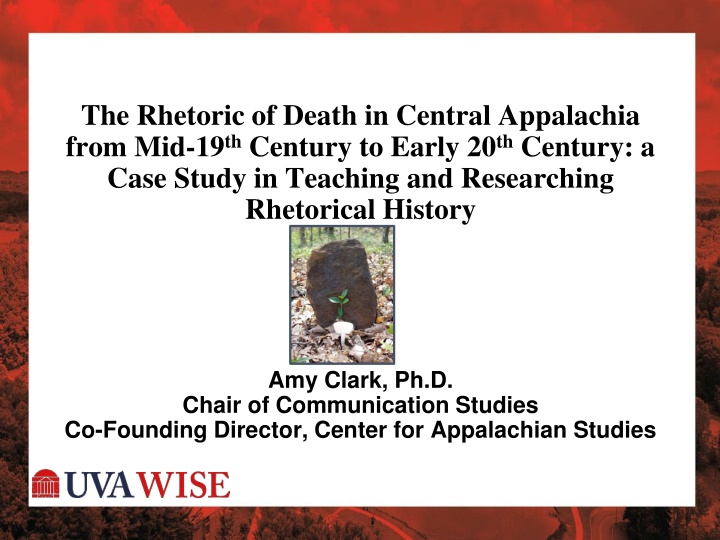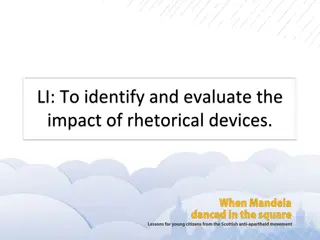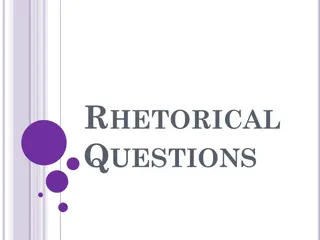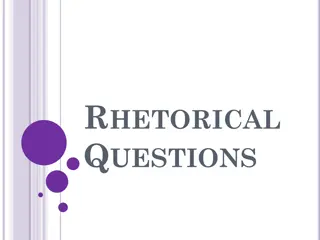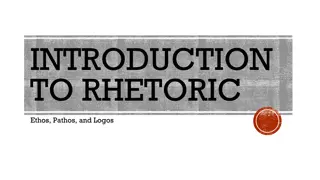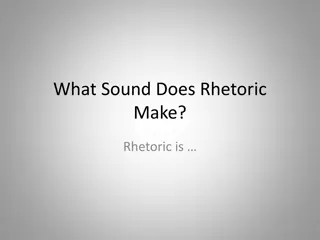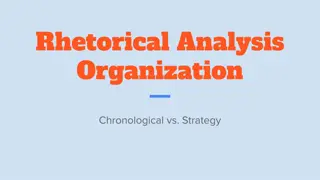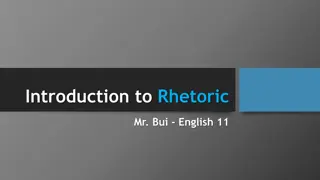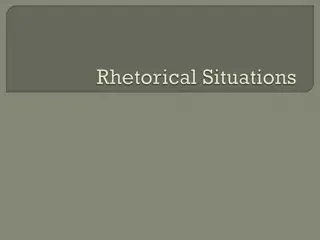The Rhetoric of Death in Central Appalachia: A Case Study in Rhetorical History
Explore the role of rhetoric in Central Appalachia's material culture through traditional gravestones, studying beliefs and values using artifacts, semiotics, and the evolution of cemetery symbolism over time. Discover how codes on graves convey messages on death and grief within the Appalachian context.
Download Presentation

Please find below an Image/Link to download the presentation.
The content on the website is provided AS IS for your information and personal use only. It may not be sold, licensed, or shared on other websites without obtaining consent from the author.If you encounter any issues during the download, it is possible that the publisher has removed the file from their server.
You are allowed to download the files provided on this website for personal or commercial use, subject to the condition that they are used lawfully. All files are the property of their respective owners.
The content on the website is provided AS IS for your information and personal use only. It may not be sold, licensed, or shared on other websites without obtaining consent from the author.
E N D
Presentation Transcript
The Rhetoric of Death in Central Appalachia from Mid-19thCentury to Early 20thCentury: a Case Study in Teaching and Researching Rhetorical History Amy Clark, Ph.D. Chair of Communication Studies Co-Founding Director, Center for Appalachian Studies
Part I: Understanding Rhetoric and Its Role in Material Culture
What is Rhetoric? (Stoner & Perkins, 2005) Public Purposeful Includes either verbal or nonverbal symbols (or both) Created with the intention of persuading Strategic
Material culture is the study of the beliefs and values of a particular culture at a given time using artifacts (Prown, 2008, p.1) Semiotics is the study of how semantic and syntactic symbols or codes govern how we move through our lives, as we decode or make meaning. Using these allied disciplines and modes of investigation, we can see how cultural objects associated with the rituals of death and grief are rhetorical by examining them as messages for the living.
Rhetorical Messages in Traditional Gravestones Codes enable people to understand and process death and grief (the color black, symbols on graves, and rituals of burial and memory (Gordon, 2014.) These codes are situated in the time and space they are created, but interpreted in differing contexts of time and space. The cemetery is a cultural landscape where social trends are illustrated in a timeline of messaging decade after decade, century after century
Sites of studies in Northern and Central Appalachia Two studies will be discussed in this seminar Appalachian Regional Commission, 2019
Context Appalachian Region is 900 miles long, following the topography of the mountain chain along the eastern U.S. Southernmost, central, and northern regions Wood and fieldstone mark the oldest graves Industrialization brought stonemasons who worked with limestone, siltstone, sandstone, granite, marble Wars and illness populated and expanded Appalachia s cemeteries Shift to granite mausoleums and obelisks among the wealthy in the 19th century Large Protestant population; religious beliefs reflected in iconography and epitaphs Cemeteries reflect the values of those in the community who hold the most power
References for Part I Gordon, A. (2014). The new semiotics of death. Retrieved from: https://www.aqr.org.uk/a/20140301-newsemiotics Prown. J.D. (2008). Mind in matter: An introduction to material culture theory and method. Winturther Portfolio 17(1), 1-19. https://www.jstor.org/stable/1180761 Stoner, M. & Perkins, S.. (2005). Making Sense of Messages: A Critical Apprenticeship in Rhetorical Criticism. 10.4324/9781351130127. Retrieved from https://www.researchgate.net/publication/270904809_Making_Sense_of_Messages_A_Critical_Apprentice ship_in_Rhetorical_Criticism/citation/download
